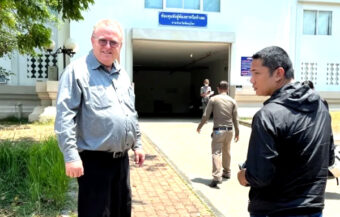The reality is that this economic crisis in Thailand is only now beginning to bite as already 10% of commercial bank borrowers who availed of debt suspension measures, are reporting problems with 6% sundering contact with their banks and walking away from debts of ฿100 billion. The new Minister of Finance, Arkhom Termpittayapaisith, revealed that some state banks may further extend a debt repayment moratorium for customers due to expire this week until March 2021.
The Thai economy, running with the continuing loss of mass tourism, a huge money-generating engine worth ฿2 trillion a year in addition to indirect economic activity, has experienced a precipitous fall-off in income earned by ordinary Thais and business concerns which is resulting in more borrowers reneging on loan repayments and the kingdom projected to reach a record household debt to GDP ratio of up to 90% by the end of this year. It comes as the government is also raising its borrowing level to keep providing support to the economy.

Despite some positive indicators from the latest export figures, Thailand’s economy is facing an uphill struggle with reports from commercial banks in the kingdom that as many as 6% of borrowers who availed of the debt moratorium period, have broken off contact with their banks concerning debt owed as the crisis bites deeper. This is reported to cover outstanding debt levels of up to ฿100 billion.
A further 4% or ฿40 billion are experiencing ‘liquidity’ problems and are attempting to negotiate with their financial institutions to cope with the current depressed economy.
It comes as new research has emerged which shows that household debt in Thailand is on target to rise to a potential level of 90% of GDP by the end of the year.
Government’s ฿1 trillion borrowing plan to support the economy may push debt to GDP as high as 57%
It comes at a time when the government has also let loose the purse strings on government debt which may rise, in the coming five years or so, to 57% of GDP under a plan drawn up by the Public Debt Management Office to manage a ฿1 trillion loan to support the beleaguered economy during this emergency.
Prior to this, the national debt stood at a respectable 48% of GDP or ฿7.7 trillion. Even at 57% of GDP, this level of debt is easily managed by Thai authorities provided the economy can regain its equilibrium and would be similar to the figure seen at the end of 2000.
The projected national debt figure is based on a growth rate of between 4 and 5% being achieved for 2021 while the Bank of Thailand is currently projecting a rate of only 3.6% based on some reopening of the kingdom to mass foreign tourism.
The kingdom’s government is legally bound to keep borrowing within a prescribed limit of 60% of GDP.
Record level of household debt shows the real story of lower incomes this year in Thailand
Already the figure for household debt in Thailand has soared in the first half of 2020 to reach 84% or the highest level on record, with Thai households owing a combined amount of ฿16.6 trillion to financial institutions.
The situation was addressed, this week, by Sethaput Suthiwart-Narueput, the newly installed 55-year-old Governor of the Bank of Thailand.
The former economist and aide to the PM admitted that the current economic data for unemployment in the post-Covid-19 emergency period masks, to some extent, the devastation caused by the shutdown of the economy in the second quarter as well as the ongoing closure of the country to mass tourism and a massive income-generating engine worth ฿2 trillion per year.
Mass tourism income is more valuable to Thailand than exports as it all goes to the bottom line
An economist this week highlighted the significant blow that the loss of mass tourism signifies to the Thai economy by comparing it to exports which require imports and raw material purchases from Thai firms.
The respected economist suggested that to replace the Thai tourism industry, arguably and strategically, the most valuable tourism industry in the world to any country, would necessitate Thailand, with an economy dependent on exports and tourism, increasing its export base by a further ฿4 trillion overnight.
It was also pointed out that as well as being ‘net’ income or profit to the bottom line that the income represented 12% of GDP, foreign tourism income also generates a further 8% in indirect economic activity to support it.
All this is income that feeds its way directly into the economy and the large numbers employed in Thailand’s huge grey economy.
Bank of Thailand boss acknowledges the significant loss of income to Thai households caused
This was acknowledged this week, by Mr Sethaput when he explained that the reason for the smaller dip in unemployment seen in comparison to the heavy impact on households within the financial system was that many Thai people were simply not earning enough while others have retired back to the land during this time of emergency.
This is the reality of Thailand’s economy, very much still off the books, very much still a grassroots affair.
On Thursday, October 22nd, the debt repayment holiday for debtors across the financial system expired.
Finance Minister working to extend loan moratorium periods for borrowers in difficulty
Details were given by the new Finance Minister, Arkhom Termpittayapaisith. He confirmed that 12 million bank accounts had availed of the scheme representing a total debt of ฿5.5 trillion.
The minister said that 30% of the debt or approximately ฿1.9 trillion was concerned with state-run lending institutions.
The minister disclosed that the Bank of Agriculture and Agricultural Cooperatives (BAAC), one of the state-owned lenders, had now agreed to further extend the debt repayment holiday until March while he believed that the Government Savings Bank and Government Housing Bank would also follow suit.
The new Governor of the Bank of Thailand, Mr Sethaput, however, said that matters between commercial banks and borrowers in difficulty will be for the banks to manage according to normal commercial practice.
Central Bank does not see Thailand’s economy as back to anything like normal until late 2022
The Central Bank is now working towards a projected return to growth in Thailand in the second half of 2021 but is warning that it will be the latter half of 2022 before the economy is back to anything like the growth seen in former years.
The bank has introduced debt relief measures including a moratorium on repayments for small and medium-sized business accounts (SMES) applicable to those with a credit line of ฿100 million or less.
This scheme, which will run up until June next year, is on a case by case basis dependent on the circumstances of the firms involved.
The bank considered that a similar scheme with a blanket approach would be a moral hazard and would discourage financial discipline.
The Bank of Thailand boss reached out to firms experiencing difficulties to encourage them strongly to contact their financial institutions to discuss their affairs.
‘Today’s debt suspension could result in a debt balloon for the next day, increasing the financial burden of borrowers,’ Governor Sethaput said. ‘Therefore the central bank wants to ask borrowers who cannot service debts to contact banks about debt restructuring.’
Get all our latest stories, follow Thai Examiner on Facebook here
Further reading:
Glimmer of hope for the ailing Thai economy as exports and business registrations decline slows
Central, Robinson department stores in expansion mode showing 2020 economy is not all bad news
Warning signs in new banking and employment reports as virus crisis hits Thailand’s bottom line hard
June export figures show a 23% decline on last year but the economy will recover by end of 2021
Prime Minister indicates that the cabinet reshuffle will be complete very shortly with no problem
Somkid ready to bow out of government as September cabinet reshuffle seems to be on the cards
Election of Prawit as Palang Pracharat leader will see more grassroots politics in government


















